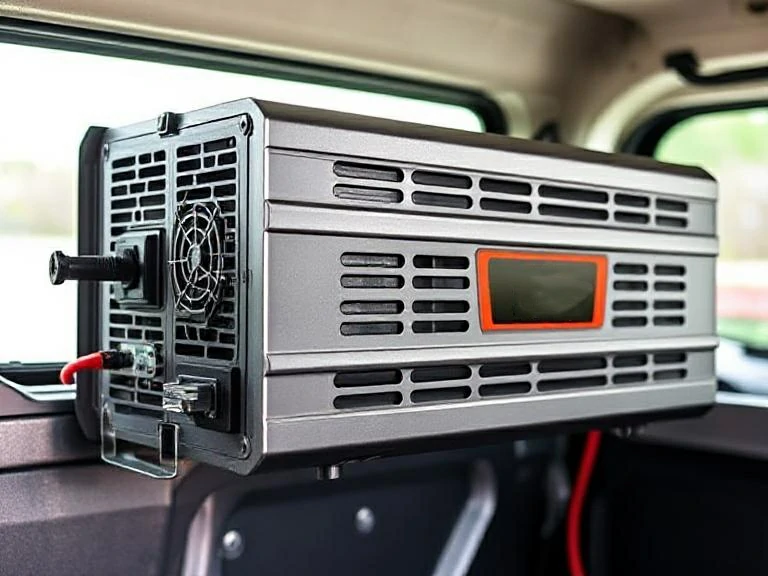Guide To Modern Power Inverter For Home: Performance, Pricing, And Safety

Power cuts are quite common and can happen in any home. If you do not wish to sit in the dark during power cuts, then it may be time to consider getting a power inverter for home. It helps you continue using your fans, lights, and other important devices when the power goes out. But choosing the right one is not always easy. You might have questions about its performance, how much it costs, and whether it is safe to use at home. In this blog, we will help you understand all of this in a simple way. So keep reading.
What is a Power Inverter and How Does it Work?
A power inverter for home is like a bridge between the power source and the devices we use every day. It takes the electricity made by batteries or solar panels, which is called direct current or DC and changes it into alternating current or AC, which is used by home appliances. Without an inverter, the power from solar panels cannot run your TV or fridge. Inside the inverter, the DC power is switched rapidly and passed through circuits that convert it into AC power. This process makes sure all the energy from the solar back up system can be used safely and properly.
Understanding Inverter Performance
To understand how well an inverter can perform, look into the following:
1. Output Voltage and Frequency
This shows how stable the inverter output is. Most household inverters give 220 V at 50 Hz, which is needed for running everyday appliances.
2. Efficiency
Efficiency is how much input power is converted to useful output. For example, if 1000 W goes in and 950 W comes out, that is 95% efficiency for a power inverter for home.
3. Harmonic Content
Harmonics affect how clean the power is. Sine wave inverters usually have less than 5% THD, which is good quality.
4. Response time
This is how quickly the inverter power is up and settled. A response time of 50 ms is ideal for keeping things running smoothly.
Key Features That Protect You and Your Devices
The following table depicts the key safety features of power inverter for home:
| Feature | What It Does |
| Overload Protection | Automatically shuts off the inverter when too many devices are connected. |
| Short-Circuit Safety | Prevents damage to appliances during sudden wiring faults or accidents. |
| Battery Overcharge Control | Stops charging once the battery is full to avoid overheating or damage. |
| Low Battery Alert | Gives a warning when the battery level is too low for safe operation. |
| Auto Switch During Power Cuts | Quickly shifts to battery power without interrupting your devices. |
| Cooling Fan or Ventilation | Keeps the inverter cool and prevents overheating during use. |
| Surge Protection | Protects connected devices from sudden voltage spikes. |
| Child Safety Features | Comes with covered sockets or safe edges to avoid accidents at home. |
A Look at Inverter Pricing
The price of an inverter depends upon several factors, such as:
● Battery Capacity and Type
Bigger capacity means more backup, which in turn means a higher price. Lead-acid batteries are budget-friendly, while lithium batteries cost more but offer longer life.
● Brand Reputation and Quality
Well-known brands offer better quality, reliability, and service. A trusted brand can save money in the long run by reducing maintenance and replacement costs.
● Technology
Inverters with features like fast charging, deep discharge handling or low maintenance cost more but offer better performance and longer life.
● Market Factors and Warranty
Pricing is also affected by raw material cost, tax, and market trends. Inverters and batteries with longer warranties usually cost more but offer more value and security.
Choosing the Right Power Inverter for Home
Given that you now have an idea about the details, the following tips will help you make the right choice:
Identify your Power Needs
List the devices you will want to run during a power cut and add up their wattage. Understand your base power requirement.
Check the VA Rating
VA (volt-ampere) tells you the size of the inverter needed. Divide your power requirement by the power factor, which is usually 0.7 or 0.8. Go for an inverter around 250 VA to ensure efficiency and safety.
Choose the Right Battery
The battery decides how long your inverter runs. Battery capacity is measured in Ah. If you want six hours of backup for 170 W, go for at least a 150 Ah battery. Use a battery calculator for more precise needs.
Match the Set-up to Your Home Size
If you have a small home, a 250 VA inverter +100 Ah battery should serve the purpose. If you have a medium home, a 500 VA inverter +150 Ah battery is considered ideal. And if you have a large home, go for an inverter, which is 1000 VA and a battery, which is 200+ Ah.
Wrapping Up
Buying a power inverter for home doesn’t have to be overwhelming. When you understand how pricing works, what performance to accept, and the key safety factors to check, it becomes a lot simpler. With the right battery, proper rating and reliable brands, you can enjoy stable power and extended performance. A smart choice today can prevent stress tomorrow.





